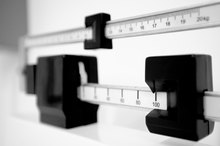How Much Does Body Weight Affect Your Cycling Speed?
Every time cyclists excel on their bikes or try to bring their bikes up to speed to stay with a group, their weight comes into play. Since heavier riders have to work harder than their thinner counterparts to maintain the same speed, it's no wonder that the world's fastest cyclists are thin and have a very low body fat percentage. Every additional pound literally takes seconds off the time it takes to ascend a steep climb.
The Effects of Weight
The heavier a rider is, the greater his energy requirements will be 2. This translates into putting in extra effort, especially during a climb. Equipment also comes into play and adds weight to the total amount, which is why you'll often see professional cyclists throwing water bottles off of their bikes before the end of a race. On rolling terrain and steep climbs, a lighter rider will come out ahead. The heavier rider will have less of an advantage because he will also have to overcome more gravitational forces.
- The heavier a rider is, the greater his energy requirements will be 2.
- Equipment also comes into play and adds weight to the total amount, which is why you'll often see professional cyclists throwing water bottles off of their bikes before the end of a race.
The Cost of Extra Weight
How to Use a Balance Beam Scale
Learn More
Numerous studies have been performed to show just how much weight effects a cyclist 1. Bicycling Magazine published the results of a study from James C. Martin, Ph.D., assistant professor in the department of exercise and sport science at the University of Utah. Using the calculations from a 160-lb. rider on a 5 kilometer, 7 percent grade, he concluded that for every 5 lbs. added to a rider, it would take him an additional 30 seconds to ascend a steep climb.
- Numerous studies have been performed to show just how much weight effects a cyclist 1.
- Bicycling Magazine published the results of a study from James C. Martin, Ph.D., assistant professor in the department of exercise and sport science at the University of Utah.
Power to Weight Ratio
The power to weight ratio measures how much power, in watts, a cyclist can produce at a certain weight, which is measured in kilograms 1. Athletes have access to these power numbers by using a power meter, which is mounted on the bike and transmits power numbers to a cyclist's handlebar-mounted computer. A heavier rider will have to produce more watts than a lighter rider to ascend the same climb.
- The power to weight ratio measures how much power, in watts, a cyclist can produce at a certain weight, which is measured in kilograms 1.
- Athletes have access to these power numbers by using a power meter, which is mounted on the bike and transmits power numbers to a cyclist's handlebar-mounted computer.
Managing Weight
Difference Between Gazelle Edge & Gazelle Freestyle
Learn More
If your aim is to become a faster rider, there are several ways to reach this goal. The most obvious is to lose weight. But many coaches prefer to work on an athlete's power numbers through increased interval sessions and off-season gym work, as opposed to strictly limiting calories. When athletes lose weight, they must aim to lose fat, instead of muscle. If you are dieting to lose weight, be sure you are consuming enough calories and carbohydrates to provide your body with the proper fuel for training.
- If your aim is to become a faster rider, there are several ways to reach this goal.
- When athletes lose weight, they must aim to lose fat, instead of muscle.
Related Articles
References
Writer Bio
A professional writer since 2004, Abby Roberts holds a Bachelor of Arts in writing and has worked as a magazine editor, a staff writer and as a freelance writer for "Muscle and Fitness Hers" magazine. Roberts also produces a blog for female cyclists. She has experience working with cyclists in different facets of training and performance enhancement.








